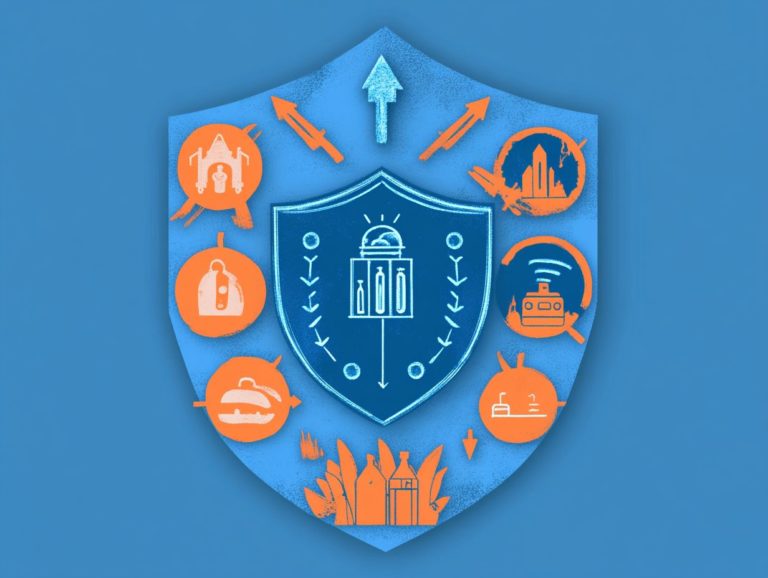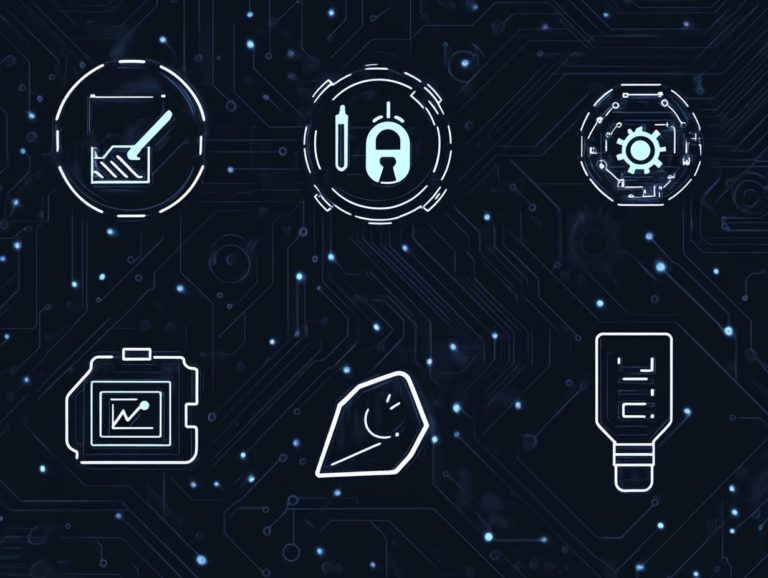best practices for remote incident response teams
In today s fast-paced digital landscape, Remote Incident Response Teams (RIRTs) specialized groups of cybersecurity experts have become vital frontline defenders against cyber threats.
Let s explore the amazing benefits these teams offer, including efficiency, cost savings, and enhanced flexibility. However, operating remotely comes with its own set of challenges, particularly regarding communication and security.
To effectively manage RIRTs, it s essential to establish clear protocols and leverage technology for seamless collaboration. It’s crucial to prioritize training and mental health support for these teams.
Dive in now to learn how to enhance your incident response in a remote world don t wait until it s too late!
Contents
Key Takeaways:

Establish clear protocols and procedures to ensure efficient and effective incident response planning for remote teams.
Utilize technology to facilitate collaboration and communication among remote teams, improving accessibility and flexibility.
Continual education and support for remote incident response teams can address mental health and prevent burnout while promoting skill development, such as understanding how to leverage external expertise for incident response.
What are Remote Incident Response Teams?
Remote Incident Response Teams (RIRTs) are specialized groups of cybersecurity professionals tailored to address cybersecurity incidents, especially in a world where remote work has surged due to the COVID-19 pandemic.
These teams are ready to tackle any cyber incident that comes their way, using a structured incident management approach and appointing an incident commander to effectively guide the response process.
RIRTs operate through dedicated incident channels, ensuring streamlined communication and meticulous adherence to protocols for swift action and resolution.
Their effectiveness hinges on the ability to implement containment actions rapidly, leveraging remote tools to assess threats and mitigate risks in real time.
Each team member plays an essential role, from analysts who monitor systems to engineers who deploy solutions remotely, all working to safeguard your organization s data.
RIRTs utilize advanced technologies like virtual private networks (VPNs), which help secure internet connections, and remote desktop software to ensure secure communications while executing their response strategies.
This collaborative approach not only enhances operational resilience but also minimizes downtime, enabling organizations to navigate incidents with agility and confidence.
Benefits of Remote Incident Response Teams
Remote Incident Response Teams (RIRTs) provide you with a wealth of advantages. They significantly enhance your efficiency in tackling cybersecurity incidents, allowing for swift resolutions without the need for a physical presence, which translates into cost savings.
This increased flexibility means you can enjoy round-the-clock monitoring and the ability to escalate incidents promptly. Such adaptability is crucial for incident preparedness, ensuring your organization can respond effectively while accommodating the varied schedules of your distributed teams.
Efficiency and Cost Savings
Efficiency and cost savings stand out as two critical benefits of engaging Remote Incident Response Teams (RIRTs). By streamlining incident management processes and addressing the challenges in incident response planning, you can significantly reduce the operational expenses tied to onsite responses.
When you adopt structured runbooks, RIRTs provide a standardized approach to incident resolution, effectively minimizing the confusion and time typically associated with these situations.
Utilizing advanced technology allows for seamless communication and collaboration among team members, regardless of their location. This agile response capability reduces the need for travel, directly translating into substantial savings on transportation and lodging.
The ability to scale teams quickly based on needs helps you allocate resources efficiently, ultimately enhancing overall productivity and operational effectiveness in handling incidents.
Flexibility and Accessibility
Flexibility and accessibility define Remote Incident Response Teams (RIRTs). They allow access to a global talent pool and enable quick mobilization of technical experts for urgent cybersecurity incidents, making it crucial to know how to assess incident response readiness.
This inherent flexibility allows your team to adjust to changing demands. It also significantly enhances their ability to respond to threats in real-time.
You can use technologies like Zoom for uninterrupted video conferences, enabling team members to collaborate visually, regardless of time zones.
Tools like Jira help manage tasks effectively, keeping everyone updated and accountable during critical engagements.
By adopting a remote framework, your team can operate around the clock, optimizing resources and cultivating a culture of agility that is vital in today’s fast-paced digital landscape.
Challenges of Remote Incident Response Teams

While RIRTs offer substantial benefits, be aware of the challenges they encounter.
Communication barriers, coordination issues among distributed teams, and critical security considerations require careful attention to ensure effective incident management.
Communication and Coordination
Effective communication and coordination are essential for the success of RIRTs. They ensure that all team members are aligned and informed during cybersecurity incidents.
In an era when remote collaboration has become standard, leverage dedicated incident channels within platforms like Slack or Zoom to enhance information flow.
Establishing clear protocols for incident communication allows your team to manage critical updates smoothly, reducing confusion during crises.
It’s vital for your team to adopt structured messaging formats and schedule regular check-ins. This promotes transparency and cultivates trust among members.
This proactive approach can lead to quicker response times and more efficient resolutions of security incidents!
Security Considerations
Security considerations are paramount for you as a member of RIRTs, especially when confronting incidents that may involve data breaches. You must carefully handle the specific issues that come with remote work.
This means ensuring strong data protection measures are in place to safeguard sensitive information, often dispersed across various platforms and devices.
Communication security is just as critical; utilize secure channels to share confidential information, significantly reducing the risk of interception by malicious actors.
Proactive incident preparedness allows you to respond efficiently to threats. Implement robust protocols and best practices tailored to your operational context.
By integrating risk management strategies, employing encryption, and conducting regular training, you can effectively mitigate potential security challenges while preserving the integrity of your incident response processes.
Best Practices for Managing Remote Incident Response Teams
Mastering the management of RIRTs involves establishing clear protocols and best practices that guide your incident management procedures.
This structured approach ensures an efficient response to cybersecurity incidents, allowing you to navigate challenges with confidence and precision.
Establishing Clear Protocols and Procedures
Establishing clear protocols and procedures is essential for Remote Incident Response Teams (RIRTs). This ensures you have a standardized approach to incident management, allowing for swift responses and effective mitigation. To enhance your team’s effectiveness, consider learning how to train your team for incident response.
These protocols form the core guidelines for incident response, detailing step-by-step actions during an incident. Clearly defined escalation policies empower your team to quickly recognize critical situations and know when to seek higher-level support.
This structured framework cultivates a culture of preparedness and enhances communication channels, ensuring that every team member understands their role. By integrating meticulous protocols with these tools, you can minimize response time, maintain operational integrity, and effectively safeguard your organization s assets against unforeseen challenges.
Utilizing Technology for Effective Collaboration

Utilizing technology for effective collaboration is essential for you and your Remote Incident Response Teams (RIRTs), facilitating real-time communication and coordination across your distributed teams. Incorporating the top 10 incident response best practices can further enhance your team’s effectiveness.
In today s digital landscape, a variety of tools can significantly enhance synergy within your RIRTs, allowing for swift and effective incident responses.
For example, platforms like Jira act as comprehensive task management systems, enabling you to track progress, assign responsibilities, and streamline workflows with ease. Meanwhile, Opsgenie plays a crucial role in delivering alerts, ensuring that critical notifications reach the appropriate team members without delay, thereby reducing response times.
By harnessing these technologies, you can elevate your operational efficiency and cultivate a proactive mindset, enabling your team to anticipate issues before they escalate.
Training and Development for Remote Incident Response Teams
Training and development are essential for enhancing the effectiveness of Remote Incident Response Teams (RIRTs). By prioritizing continuous education, you ensure that your team members remain informed about the latest cybersecurity threats and best practices, including the essential elements of an incident response plan.
This commitment directly tackles the mental health and burnout challenges that often arise in high-pressure environments, fostering a more resilient and capable team.
Continual Education and Skill Development
Continual education and skill development are paramount for you and your Remote Incident Response Team (RIRT) to maintain proficiency in incident management and learn how to improve incident response time as you keep pace with the ever-evolving landscape of cybersecurity threats.
To achieve this, you can delve into a range of training methodologies. Consider immersive online courses that simulate real-world scenarios and challenges. Workshops, whether virtual or in-person, offer you hands-on experience through collaborative problem-solving exercises.
Pursuing certifications from respected organizations not only validates your expertise but also instills confidence in your stakeholders. By dedicating time to these resources, you can significantly enhance your team’s capabilities, ensuring swift and efficient responses to incidents.
Embracing ongoing learning cultivates a culture of resilience and adaptability, which is essential as new threats continually emerge in the cybersecurity realm.
Addressing Mental Health and Burnout
Addressing mental health and burnout is essential for you as a member of a Remote Incident Response Team (RIRT), especially considering the high-pressure environment of responding to cybersecurity incidents, where the stress can take a substantial emotional toll.
You might find yourself grappling with exhaustion, anxiety, and irritability key signs of burnout that arise from relentless demands and the constant vigilance required in your role. Recognizing these indicators is crucial for creating a productive work atmosphere.
To promote your well-being, management can implement several effective strategies, such as:
- Regular mental health check-ins
- Access to counseling services
- Fostering open communication
- Encouraging flexible work schedules
Providing training on stress management techniques and cultivating a culture that prioritizes mental health can significantly boost both your resilience and the overall performance of your team.
Frequently Asked Questions
Best Practices for Managing a Remote Incident Response Team

Establish clear communication channels and set expectations for response times. Regular check-ins ensure team well-being and productivity.
Ensure Collaboration in Your Remote Team
Use virtual collaboration tools like video conferencing and chat platforms. Clearly define roles and encourage open communication.
Protect Sensitive Information
Use secure and encrypted communication channels. Strong passwords and ongoing education on cybersecurity are vital.
Challenges in Managing a Remote Team
Communication and collaboration can be tough. Lack of access to tools may hinder motivation and engagement.
Boost the Effectiveness of Remote Response Procedures
Regularly review and update your procedures with new technologies. Conduct frequent training sessions to keep your team prepared.
Maintain Team Morale and Motivation
Celebrate your team’s successes and show appreciation for their contributions. Offer chances for professional growth to keep spirits high.






